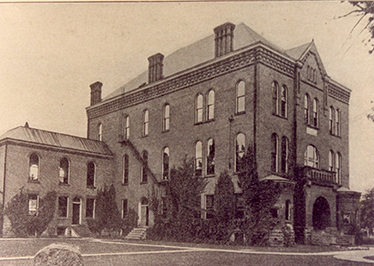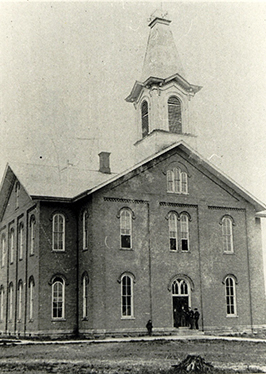 Founders Hall
Founders Hall
Part two of a series on the iconic architecture of campus by Alyssa (Jackson ’19) Bootsma
Rockwell Hall stands tall as the iconic centerpiece of Grove City College today. The clock tower and symmetrical structure overlook the Quad atop a slight hill, making it not only a landmark but also a signature of the town. In the late 19th century, the main campus did not inhabit the land above Wolf Creek, where today’s many buildings create a beautiful pattern. Instead, what is known as “lower campus” today housed the College’s original architecture. As the College continued to mature in its beliefs, core courses and leadership, the physical pieces of the College transitioned in the next 100 years.
Isaac C. Ketler, the Principal of Pine Grove Academy (while it was named such), continued to serve as the first President of Grove City College after it was accredited as a college in 1884. Under Ketler, the campus expanded from a simple schoolroom to six main buildings: Recitation Hall, the Music Hall, Physics Building, Founders Hall, Carnegie Library and the Ivy Chapel.
But the College didn’t build autonomously. The surrounding community eagerly assisted in the funding and construction of the first building in 1879 eventually known as Recitation Hall. Other names included College Building, Original College Building and the Academy Building.
Recitation Hall proved a community effort, as citizens raised money or offered their time and resources to make the building possible. Some hauled stone and brick for the new school. One young farmer proudly placed two silver dollars in the collection for the school. The total cost of the building, furniture, bells, stoves, and grounds was $8,607.33, which was no trivial amount for a small town in the late 1800s.
The building of Recitation Hall was not the only community effort in the early days. Out of town students would stay in private rooms of local residences, paying a rent of $3-$3.50 a week. Students could also stay in boarding houses, and do what was deemed “Clubbing,” in the Pine Grove Academy Calendar for 1877-1878. Students “finding nothing but eatables, room, fuel and light furnished” could pay $1 per week. The groups in the houses were called “clubs” because students with similar interests or qualities were grouped together. Or they could be “self-boarders,” paying $1 a month per student and living in a room with a local family.
 Recitation Hall
Recitation Hall
As enrollment grew, Dr. William J. McConkey, pastor of the Presbyterian church in town and an administrator of the College, built a wood frame house in 1879 to provide more housing. The College purchased the building in 1895, rebuilding it and adding a brick facing and cornerstone. It continued as a Music Hall until Carnegie Hall transitioned into that role in 1957.
The Carnegie Library was built in 1901 by industrialist Andrew Carnegie and served as a free library, then a gymnasium and music hall, providing accessible literature to the College and the Grove City Community.
In 1883 a building had been constructed and intended as a music hall. But when the College acquired McConkey’s building for that purpose, the former then became known as the Library Hall, with classrooms for typing, stenography, telegraphy and preparatory work. In 1897, the Library was moved into the first floor of the building and the fine arts department occupied the second floor. In the same year, a boiler house was built onto the side of the building providing heat for all College facilities. The military department also was located at Library Hall until it moved to the Music Hall after WWII.
The Library Hall transitioned to a science building in July 1901, when the Pennsylvania Legislature and Governor proposed $20,000 to establish a department of mechanical and civil engineering at Grove City College. The multipurpose building was renovated to add labs and classrooms, and by the 1909-1910 academic year became known as the Physics Building. It served as the main science building until Rockwell was built in 1931 followed by Hoyt Hall in the 1960s.
Founders Hall was constructed in 1888 and housed the President’s office and administrative offices. It also had an auditorium, gymnasium and chemistry labs.
As a Christian college, upholding and teaching biblical standards was and remains a bulwark of the establishment. As the 1876-1877 College Catalogue states “The general exercises of each day are commenced with reading the Scriptures and prayer. Hereafter singing will be added to the morning exercises.”
In order to provide a church service for the College students, the Ivy Chapel was built by United Presbyterian in 1893. The College shared and used it for Chapel services, but then purchased it from the church in 1908. The Academy had a requirement that students attend preaching “at least once on sabbath.” As the catalogue stated, “A number of churches of different denominations are within easy access of the school,” which remains true today.
These main buildings served the College’s needs and brought the community together in a common effort to establish the school. But as the student base expanded, and the country became affluent and more immersed in a desire for education, the College needed to keep pace. Other buildings that were added in the first 30 years of the College’s existence but are now torn down include the Colonial Dorm, where the Colonial Apartments stand today, the Pelton Cottages on the corner of Broad and College and Ketler Gym.
The College was young but hearty and continuing to grow. At the turn of the century, enrollment had soared to 660 students. With the turn of the century came the eve of the first World War and the Depression. How would Grove City College respond in times of dire need? Follow along for the next story on the College’s strength in the early 1900s, and the testing waters of an infamous era in American History.
Read the Building a Legacy Series
Part 1: Campus buildings tell College’s story
Part 2: Creating a campus in the community
Part 3: Growth in the midst of the Depression
Part 4: Weathering the war and completing the plan
Part 5: The Surge of the 60s, 70s and 80s
Part 6: The 21st century